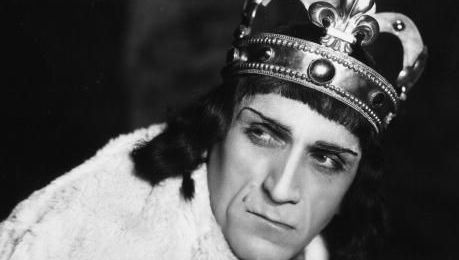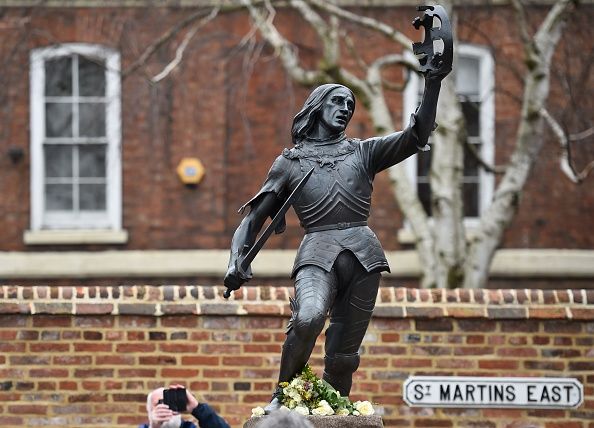
Balliol Holloway as Richard IIIImage:Getty Images
Richard III was the King of England and Lord of Ireland until his death at the Battle of Bosworth Field. He was the last of the Plantagenet Dynasty and was laid to rest in Leicester in 2015.
England’s last Plantagenet King was laid to rest after 530 years. The only monarch since the Norman Conquest not to be buried in a royal tomb, King Richard III was interred with the full panoply of royal honors in Leicester Cathedral. For five centuries, his human remains lay unmarked, unnoticed and forgotten only yards across the cathedral yard under what was a civic parking lot.
British Heritage readers have been following the story with me since the remarkable discovery of Richard III’s bones by a University of Leicester Archaeological team in August 2012. The next spring we went up to North Yorkshire to tell the back-story of this controversial and much-maligned monarchy in his home base as Lord of the North.
READ: Everything you need to know about the Favorite's Queen Anne
 5
5
King Richard III
Leicester is ready

King Richard III
Originally a Roman settlement, Leicester evolved over the centuries from medieval county town to working class industrial center. It gained city status and a cathedral in the early 20th century. Today Leicester is a multi-cultural metropolis of 330,000 known for the diversity of its population and eight commonly-spoken languages. Leicester’s ethnic communities have united in pride and enthusiasm at the city’s newfound celebrity and the fame garnered by its university.
Since my first visit to interview the University of Leicester team who made the discovery of Richard’s bones years ago, the central city precincts surrounding Leicester Cathedral have been transformed with civic work in preparation for King Richard’s reburial and for the expected food of visitors from around the world to follow.
Visitor Center
Center stage in Leicester’s urban renewal is the new Richard III Visitor Center. Just across the beautifully landscaped pedestrian square from Leicester Cathedral, the center is brightly conceived and beautifully presented, recounting the story of Richard III’s life and death as well as the fate of his remains and their serendipitous, unlikely discovery and identification. All this leads to the starring gallery—built around and over the grave where Richard’s bones lay.

Richard III Visitor Center Leicester
READ: Ramble the Fosse Way
Finding the King
Finding the body of King Richard III goes down as one of the great archaeological discovery stories of all time. In addition, their identification solves one of the great mysteries of British history. The attention this story has received in the media and the public interest it has generated are well-deserved.
Philippa Langley and the Richard III Society that championed the dig deserve their bows as well. Richard Buckley, lead archaeologist on the project was given an OBE, and celebrity has come also to osteologist Jo Appleby and geneticist Turi King who dusted off and identified the skeleton as the last Yorkist king.

The Remains of King Richard III
Mystery remains
Finally, Richard III rests in his royal tomb in Leicester Cathedral. Leicester has a sparkling new center-city district. It also has what the tired east Midlands city lacked—a major new tourist attraction.
The benefits to Leicester will be ongoing, and much appreciated by its people. How ironic that the reviled monarch whose battle-hacked body was so unceremoniously dumped and ultimately forgotten in Leicester should in the end convey such bounty to the city.
While the buzz surrounding King Richard III inevitably declines, the controversies over his character, his reign and, most dramatically, his imputed complicity in the famed, unsolved murder in the Tower of the young princes (sons of his brother, King Edward IV) remain. Richard’s notoriety and celebrity will not be forgotten. The lynch pin of his reputation lies in that greatest of English murder mysteries.
Will it ever be solved? Thus far, despite many theories and arguments, the mysterious disappearance of Princes Edward (King Edward V) and Richard has evaded resolution. Historians concur that it may never be a closed case. Until then, Richard of York may have an appropriate royal tomb, but is not likely to rest in peace.
READ: The Beatles and Liverpool: Exploring the history

Statue of Richard III
Visiting Leicester
By train, it takes just over an hour with frequent service from London St. Pancras.
By car, allow closer to two hours drive from London. Take the M1 north to Junction 21, then follow the A5460 into the city center.





Comments